Now Reading: Agile Affinity Mapping: Marketing Case Study
-
01
Agile Affinity Mapping: Marketing Case Study
Agile Affinity Mapping: Marketing Case Study
From Features to Feelings: Crafting a High-Resonance Marketing Campaign
A marketing team analyzed customer interview notes to develop a resonant messaging strategy for a new product launch, shifting from feature-focused copy to benefit-driven language that dramatically improved conversion rates.

The Challenge
The team needed to create a marketing campaign for a new productivity tool, but they were unsure which features or benefits would resonate most with their target audience of freelance creatives. Internal opinions were divided, leading to a generic and uninspired campaign direction. They were at risk of spending a significant budget on ads that wouldn’t connect.
The Process: From Chaos to Clarity
Before the Planner: Gathering Raw Data
Before using the planner, the team conducted 10 in-depth interviews with freelance designers and writers. They transcribed the interviews and pulled out dozens of statements related to work challenges, desired tool features, and career aspirations, adding each “voice of the customer” snippet to a spreadsheet.
Step 1: Prepare for Affinity Mapping
In the planner’s “Prepare” step, the goal was sharply defined: “Distill customer interview data into 3 core messaging pillars for the upcoming campaign.” The team was intentionally kept small and agile, including a product marketer, a copywriter, and a social media manager to ensure rapid decision-making.
Step 2: Conduct the Mapping Session
The “Conduct” plan involved a remote session where each spreadsheet entry was transferred to a card on a Trello board. The team would then collaboratively drag and drop the cards into lists representing emergent themes. They named the lists with customer-centric labels like “Saving Time,” “Managing Clients,” and “Financial Stress.”
Step 3: Analyze and Prioritize Groups
For the ‘Analyze’ step, the plan was to take the top three themes and craft a ‘Jobs to Be Done’ (JTBD) statement for each one. This framework was chosen specifically to reframe the insights from the customer’s perspective (e.g., ‘Help me look professional so I can win bigger clients’), making them more powerful for creating empathetic copy.
Step 4: Implement and Monitor Actions
In the “Implement” step, they planned to use the top 3 JTBD statements as creative briefs for ad copy, landing page headlines, and email subject lines. To validate their findings, they would systematically A/B test the new messaging against their old feature-focused copy, with click-through rate (CTR) and on-page conversion as the primary success metrics.
After the Planner: Running the Workshop
The final report guided the Trello session, which produced a major insight: while the team thought “advanced features” would be the key selling point, the interviews clearly showed customers cared most about “reducing administrative overhead” and “appearing more professional to clients.” The JTBD statements that came out of this session became the foundational DNA of the entire campaign, influencing everything from ad visuals to blog post topics.
The Results
The planner provided a customer-centric framework that shifted the team’s focus from what the product can do to what the customer can become. This pivot from features to benefits resulted in a much more effective and profitable campaign.
- Developed a campaign messaging strategy rooted in direct customer language, not internal assumptions.
- The resulting landing page, which led with the new messaging, had a 50% higher conversion rate than any previous product launch page.
- Email open rates for the campaign increased by 15% due to more compelling, benefit-oriented subject lines.
- Created a repeatable process for analyzing customer research that is now a standard part of their marketing playbook.

